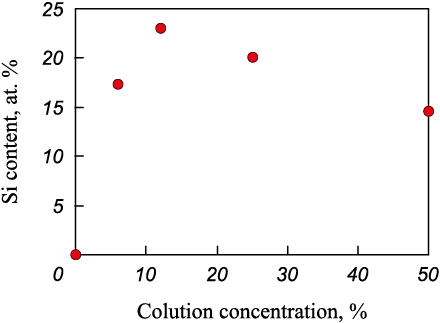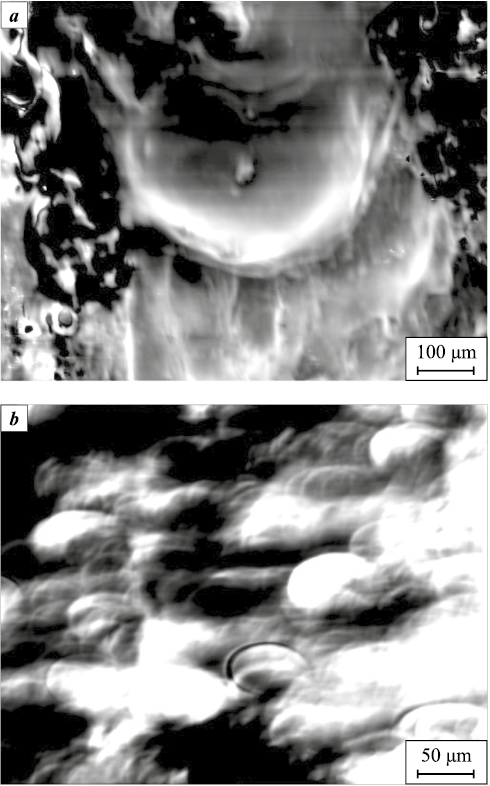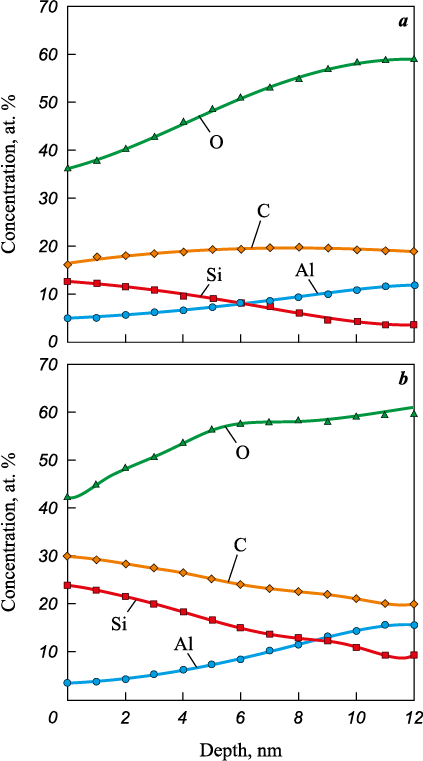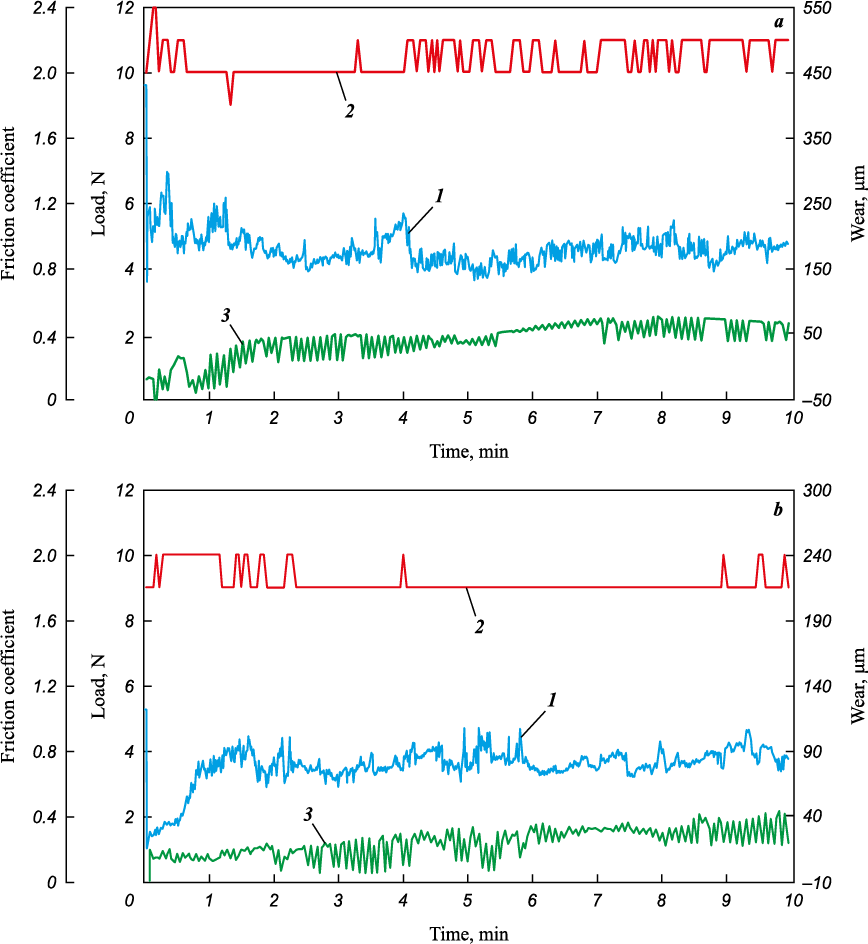Scroll to:
Formation of ceramic coating on VAL10 aluminum alloy surface via laser modification in polysilicate solution
https://doi.org/10.17073/1997-308X-2024-2-53-60
Abstract
This article presents the results of an experimental study on the physical and mechanical properties of the surface layer of the VAL10 aluminum alloy after pulsed laser treatment, conducted in a bath with an aqueous solution of polysilicates (PS) at various concentrations. Ceramic coatings were produced on specimens measuring 10×10×3 mm. The laser processing of aluminum alloy specimens was carried out using an Nd:YAG laser. The study demonstrates that the quality of the resulting surface and its properties can vary depending on the laser exposure parameters, the concentration of the polysilicate solution, and the overall processing technique. The scattering of radiation by the PS solution layer leads to a significant reduction in surface roughness. In specimens processed in ambient air, the crater sizes on the surface exceeded 400 μm, while for specimens processed in a PS solution, they did not exceed 100 μm. A comparative analysis of the impact of solution concentration on elemental composition was performed. The study also included an investigation of friction characteristics and the measurement of microhardness of the modified surface. The research revealed that surface hardening processes occur as a result of the treatment, associated with the filling of recesses with high-strength oxides. This enabled the creation of a mixture containing silicon carbide and aluminum oxide in the surface layer of the specimens. Furthermore, wear tests of the modified surface were conducted using a “ball–specimen” tribological coupling. Specimens subjected to laser irradiation in a PS solution demonstrated increased wear resistance (a 40 % reduction in wear) and a 30 % decrease in the friction coefficient. Additionally, an increase in microhardness was observed.
Keywords
For citations:
Kalyuzhnyi D.G., Palabugin M.V., Burnyshev I.N., Lys V.F., Ladyanov V.I. Formation of ceramic coating on VAL10 aluminum alloy surface via laser modification in polysilicate solution. Powder Metallurgy аnd Functional Coatings (Izvestiya Vuzov. Poroshkovaya Metallurgiya i Funktsional'nye Pokrytiya). 2024;18(2):53-60. https://doi.org/10.17073/1997-308X-2024-2-53-60
Introduction
In modern mechanical engineering, the pursuit of reducing the weight of final products while maintaining high performance properties, such as strength and wear resistance, and achieving a high degree of process automation, is of major importance [1–3]. In this context, the surface hardening of aluminum alloys, known for their low density and high specific strength, holds great promise [4–9]. Nevertheless, one significant drawback of these materials is their low hardness [10; 11]. Surface hardening allows for an increase in the overall wear resistance of the part.
Various methods are currently available for surface hardening of metals and alloys [12], including thermal and chemical processes, spraying, shot blasting, and laser-based techniques [13]. Modern laser systems offer advantages such as high processing speed, precision, and the ability to finely adjust energy parameters and exposure duration within the processing zone [14].
Laser modification technologies for aluminum alloy surfaces, particularly laser alloying, have made significant progress in enhancing the corrosion resistance, mechanical durability, and resistance to adhesive and abrasive wear of aluminum alloys [15]. Fusion of alloying powders with the substrate using laser radiation is a promising method for creating protective coatings on aluminum alloys [16]. This process may involve the incorporation of both metals (e.g., Ni, Cr) and non-metals (e.g., B, Si) as dopants, with a binding element being introduced into the powder composition [17]. The resulting mixture is uniformly applied to the substrate, and the surface is subsequently treated with a laser [18; 19]. t’s crucial to note that the choice of components suitable for inclusion in the aluminum alloy’s surface composition is limited, as they must have a melting point comparable to that of aluminum to ensure high-quality coating [20]. The use of other components often leads to a significant decrease in coating quality [21]. An alternative approach involves the introduction of alloying elements from the liquid phase. In this method, the part is immersed in a technological solution, and laser radiation, forming a vapor gas channel in the liquid, is directed onto the part’s surface.
Recently, metal-ceramic composite materials with an aluminum-based matrix reinforced with refractory ceramic particles of silicon carbide (SiC) have been used [22]. Composite materials with an aluminum matrix are characterized by high specific strength combined with low density. Doping with silicon carbide particles allows for the creation of a material with a low coefficient of friction and high wear resistance [23].
The objective of this study is to investigate specific changes in the mechanical properties of ceramic coatings on an VAL10 aluminum alloy, produced using laser radiation in an aqueous polysilicate (PS) solution bath. Furthermore, we aim to determine the processing parameters that can enhance the microhardness of the surface layer and its abrasion resistance.
Materials and methods.
Results and discussion
The most commonly used non-metallic dopant for aluminum alloys is silicon. Doping with silicon allows for the creation of a hypereutectic structure on the surface of hypoeutectic alloys while simultaneously increasing surface hardness. In this study, coatings were applied to 10×10×3 mm specimens of the VAL10 aluminum alloy. Surface laser processing was performed using a solid-state Nd:YAG laser with a radiation wavelength of 1.06 μm, integrated into the LIS-25 laser welding system (EIKTL Lagen LLC, Russia). Each laser pulse had a maximum energy of 25 J, a pulse duration of 5 ms, and a repetition rate of 3 Hz. During the processing, the specimen was immersed in a bath containing an aqueous solution of (Na2O)n·(SiO2)m polysilicate. The concentration of the polysilicate solution was experimentally determined to be in the range of 10–15 %. A higher concentration of polysilicate led to the release of gas bubbles from the medium, which significantly reduced the efficiency of laser radiation delivery to the specimen’s surface and caused pronounced splashing of the polysilicate solution. On the other hand, a lower concentration resulted in a noticeable decrease in the silicon content within the coating (Fig. 1).
Fig. 1. Relationship between the silicon content |
The layer of the liquid medium above the processed specimen’s surface was consistently maintained at a 1 mm thickness. Reference specimens were also prepared and treated in both air and distilled water. Due to the scattering of radiation by the layer of PS solution positioned above the specimen’s surface, the surface irregularities were significantly reduced.
As a result, for specimens treated in ambient air, crater sizes on the surface exceeded 400 μm, whereas when a PS solution was used, the exposure marks did not exceed a 100 μm diameter (Fig. 2).
Fig. 2. Surface images of specimens |
The layer created by laser processing on the metal surface enhances the part’s durability and performance. Laser processing of the aluminum alloy results in the redistribution of chemical elements throughout the depth of the material. The craters formed on the surface become filled with silicon and aluminum compounds. The chemical composition of the specimens was analyzed using a JAMP-10 S Auger analyzer (JEOL, Japan). The shape of the Auger lines indicated that aluminum exists in an oxidized state, while carbon and silicon are in the carbide state (Fig. 3).
Fig. 3. Element distribution across the surface layer at polysilicate solution |
The size and relative positioning of the surface recesses are determined by the processing mode and the concentration of the PS solution. The absence of crater overlap prevents complete coverage of the surface, leading to discontinuities in the ceramic layer. In untreated areas, the base metal remains exposed, resulting in a heterogeneous ceramic coating layer.
One of the critical operational parameters influencing the quality of the surface-hardened layer is wear resistance. Fretting wear tests were conducted using an SRV Testsystem multifunctional testing device (Optimol Instruments, GmbH, Germany) at room temperature, following the disk-on-ball configuration without lubrication. The counterbody material was ShKh15 tool steel after hardening heat treatment. The tests were carried out with a vibration amplitude of 3 mm, a frequency of 2 Hz, a load of 10 N on the specimen, and a test duration of 10 min. Based on the results, it can be concluded that the amount of wear on the surface of the VAL10 alloy specimen after laser processing in a PS solution was less than 40 μm, while the untreated specimen exhibited 60 μm of wear. During testing, the friction coefficient for the treated specimen slightly exceeded 0.8, while the original specimen had a noticeably higher friction coefficient of over 1 (Fig. 4).
Fig. 4. Results of fretting wear tests of the original VAL10 alloy specimen (a) |
The presence of oxide and carbide components in the surface layer after laser processing is expected to influence microhardness. Microhardness of the surface of a VAL10 aluminum alloy specimen with an applied oxide coating was evaluated using a LOMO PMT-3M microhardness tester (LOMO, Russia). A 4-sided Vickers diamond pyramid served as the indenter. The results indicated that the average diagonal size of the indentation was 50 μm under a load of 0.196 N and a dwell time of 15 s, corresponding to a hardness of 14.8 kg/mm2. In comparison, the microhardness of the original specimen was determined using the same method and measured 9.1 kg/mm2, representing a 62.6 % decrease compared to the modified coated specimen. The formation of compounds with higher hardness on the surface of the aluminum alloy, in contrast to the base material, can also account for the reduction in the friction coefficient.
Conclusions
Analysis of the modified surface of VAL10 aluminum alloy specimens revealed the dependency of surface layer properties on the modification parameters. By adjusting laser processing parameters, such as pulse repetition rate, surface fill factor, concentration, and the thickness of the solution layer above the specimen’s surface, it becomes possible to control the extent of the impact and, consequently, the chemical composition of the resulting coating.
The study conclusively demonstrated that laser processing of VAL10 alloy specimens in a polysilicate solution has a significant impact on their performance. In particular, it enhances surface abrasion resistance and promotes surface hardening.
References
1. Tarasova T.V., Gvozdeva G.O., Tikhonova E.P. Prospects for the use of laser radiation for surface treatment of non-ferrous alloys. Vestnik of MGTU “Stankin”. 2012;2(20):140–143. (In Russ.). http://www.stankin-journal.ru/ru/articles/596
2. Witkin D.B., Patel D.N., Helvajian H. Surface treatment of powder-bed fusion additive manufactured metals for improved fatigue life. Journal of Materi Engineering and Perform. 2019;28:681–692. https://doi.org/10.1007/s11665-018-3732-9
3. Hatamleh M. I., Mahadevan J., Malik A. Prediction of residual stress random fields for selective laser melted A357 aluminum alloy subjected to laser shock peening. Journal of Manufacturing Science & Engineering. 2019; 141(10):101011. https://doi.org/10.1115/1.4044418
4. Smirnov S.V., Shandarov S.M., Karanskii V.V. Forced laser nanostructuring of the surface of alumina ceramics. Uspekhi prikladnoi fiziki. 2021;9(3):224–234. (In Russ.). https://doi.org/10.51368/2307-4469-2021-9-3-224-234
5. Zhihao H., Wenjun W., Zelin M. Anti-icing ceramics surface induced by femtosecond laser. Ceramics International. 2022;48(7):10236–10243. https://doi.org/10.1016/j.ceramint.2021.12.238
6. Sataeva N.E., Emel’yanenko K.A., Domantovskii A.G. Laser processing of aluminum alloys to create weather-resistant superhydrophobic coatings. Rossiiskie nanotekhnologii. 2020;15(2):158–163. (In Russ.). https://doi.org/10.1134/S199272232002017X
7. Jinliang Z.,Qingsong W., Dave B. A review of selective laser melting of aluminum alloys: Processing, microstructure, property and developing trends. Journal of Materials Science & Technology. 2019;35(2):270–284. https://doi.org/10.1016/j.jmst.2018.09.004
8. Kisel’ A.G., Belan D.Yu., Toder G.B. Investigation of the possibility of finishing laser processing of workpieces made of aluminum alloy D16. Obrabotka metallov (tekhnologiya, oborudovanie, instrumenty). 2020;22(3):33–43. (In Russ.). https://doi.org/10.17212/1994-6309-2020-22.3-33-43
9. Riveiro A., Quintero F., Boutinguiza M. Laser cutting of aluminum alloy Al-2024-T3. Procedia Manufacturing. 2017;13:396–401. https://doi.org/10.1016/j.promfg.2017.09.028
10. Kuis D.V., Volochko A.T., Shegidevich A.A., Svidunovich N.A., Omelyusik A.V., Lezhnev S.N., Mukhamedzyanova E.R., Kuznetsova О.N. Composite materials obtained by processing aluminum melt with ligatures containing carbon particles. Vestnik Kazanskogo tekhnologicheskogo universiteta. 2014;17(18):143–145. (In Russ.). https://www.elibrary.ru/item.asp?id=22480202 https://www.elibrary.ru/item.asp?id=22480202
11. Shinkaryov A.S., Ozherelkov D.Y., Pelevin I.A. Laser fusion of aluminum powder coated with diamond particles via selective laser melting: Powder preparation and synthesis description. Coatings. 2021;11(10):1219. https://doi.org/10.3390/coatings11101219
12. Kozlova A.A., Kuznetsova V.A., Kozlov I.A. Influence of prolonged heating on the properties of protective coatings for aluminum alloy of the Al–Si–Mg system. Aviatsionnye materialy i tekhnologii. 2019;2(55):74–80. (In Russ.). https://doi.org/10.18577/2071-9140-2019-0-2-74-80
13. Mariappan T. Recent developments of intumescent fire protection coatings for structural steel: A review. Journal of Fire Sciences. 2016;34(2):120–163. https://doi.org/10.1177/0734904115626720
14. Savrai R.A., Malygina I.Yu., Makarov A.V. Influence of laser alloying with Cu–Zn–Ti and Si–Cu powder mixtures on the structure and properties of cast aluminum alloy. Obrabotka metallov (tekhnologiya, oborudovanie, instrumenty). 2019;21(4):70–84. (In Russ.). https://doi.org/10.17212/1994-6309-2019-21.4-70-84
15. Wang P., Deng L., Prashanth K.G. Microstructure and mechanical properties of Al–Cu alloys fabricated by selective laser melting of powder mixtures. Journal of Alloys and Compounds. 2018;735:2263–2266. https://doi.org/10.1016/j.jallcom.2017.10.168
16. Tomida S., Nakata K. Fe–Al composite layers on aluminum alloy formed by laser surface alloying with iron powder. Surface and Coatings Technology. 2003; 174-175:559–563. https://doi.org/10.1016/S0257-8972(03)00698-4
17. Aboulkhair N., Everitt N., Maskery I. Selective laser melting of aluminum alloys. MRS Bulletin. 2017;42(4): 311–319. https://doi.org/10.1557/mrs.2017.63
18. Aleksandrov V.D., Petrova L.G., Morshchilov M.V. Laser alloying of surface layers of aluminum alloys in order to increase their wear resistance. Tekhnologiya metallov. 2019;10:33–39. (In Russ.). https://doi.org/10.31044/1684-2499-2019-10-0-33-39
19. Yiming C., Guochao G., Huijun Y. Laser surface alloying on aluminum and its alloys: A review. Optics and Lasers in Engineering. 2018;100:23–37. https://doi.org/10.1016/j.optlaseng.2017.07.006
20. Olakanmi E.O., Cochrane R.F., Dalgarno K.W. A review on selective laser sintering/melting (SLS/SLM) of aluminium alloy powders: Processing, microstructure, and properties. Progress in Materials Science. 2015;74:401–477. https://doi.org/10.1016/j.pmatsci.2015.03.002
21. Quazi M.M., Fazal M.A., Farazila Y. Laser-based surface modifications of aluminum and its alloys. Critical Reviews in Solid State and Materials Sciences. 2016;41(2):106–131. https://doi.org/10.1080/10408436.2015.1076716
22. Shiganov I.N., Samarin P.E. Surface modification of aluminum alloys with silicon carbides by laser melting. Vestnik MGTU im. N.E. Baumana. Seriya: Mashinostroenie. 2012;5:62–68. (In Russ.). http://engjournal.ru/articles/226/html/files/assets/basic-html/page1.html
23. Pratik S., Subhasisa N., Guanjun W. Surface property modifications of silicon carbide ceramic following laser shock peening. Journal of the European Ceramic Society. 2017;37(9):3027–3038. https://doi.org/10.1016/j.jeurceramsoc.2017.03.005
About the Authors
D. G. KalyuzhnyiRussian Federation
Dmitriy G. Kalyuzhnyi – Cand. Sci. (Eng.), Assistant Professor of the Department “Physics and Optotechnics”, Kalashnikov Izhevsk State Technical University; Senior Researcher of Scientific Center for Metallurgical Physics and Materials Science, Udmurt Federal Research Center of the Ural Branch of the Russian Academy of Sciences
7 Studencheskaya Str., Izhevsk 426069, Russia
34 Tatyany Baramzinoi Str., Izhevsk 426067, Russia
M. V. Palabugin
Russian Federation
Mikhail V. Palabugin – Undergraduate of the Department “Instruments and Measurement, Control, Diagnostics”
7 Studencheskaya Str., Izhevsk 426069, Russia
I. N. Burnyshev
Russian Federation
Ivan N. Burnyshev – Cand. Sci. (Phys.-Math.), Leading Researcher Scientist of Scientific Center for Metallurgical Physics and Materials Science
34 Tatyany Baramzinoi Str., Izhevsk 426067, Russia
V. F. Lys
Russian Federation
Vasiliy F. Lys – Leading Engineer of the Laboratory of Materials Science and Thermal Deformation Processes
34 Tatyany Baramzinoi Str., Izhevsk 426067, Russia
V. I. Ladyanov
Russian Federation
Vladimir I. Ladyanov – Dr. Sci. (Phys.-Math.), Chief Research Scientist of Scientific Center for Metallurgical Physics and Materials Science
34 Tatyany Baramzinoi Str., Izhevsk 426067, Russia
Review
For citations:
Kalyuzhnyi D.G., Palabugin M.V., Burnyshev I.N., Lys V.F., Ladyanov V.I. Formation of ceramic coating on VAL10 aluminum alloy surface via laser modification in polysilicate solution. Powder Metallurgy аnd Functional Coatings (Izvestiya Vuzov. Poroshkovaya Metallurgiya i Funktsional'nye Pokrytiya). 2024;18(2):53-60. https://doi.org/10.17073/1997-308X-2024-2-53-60





































